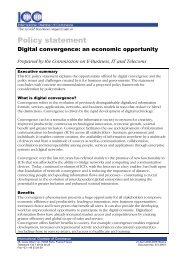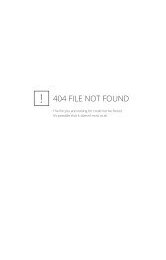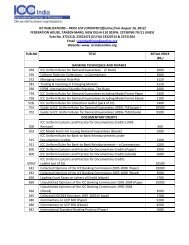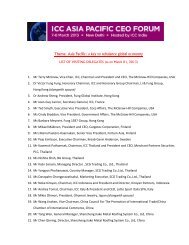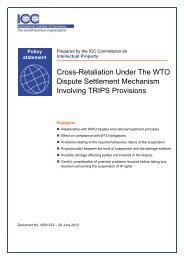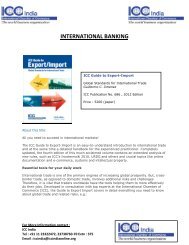2013 - ICC India
2013 - ICC India
2013 - ICC India
- No tags were found...
You also want an ePaper? Increase the reach of your titles
YUMPU automatically turns print PDFs into web optimized ePapers that Google loves.
<strong>ICC</strong> BANKING COMMISSION | <strong>2013</strong> GLOBAL RISKS TRADE FINANCE | APPENDIX B 55Loans for import and export – here it depends on whether it is a loan ora facility that can be drawn. Receivables finance, for example, is typicallya facility that is drawn upon presentation of acceptable invoices. Otherstructures such as a clean loan for import could be similar to an unsecuredterm loan.Performance guarantees – the customer may have satisfactorily performedthe task covered by the guarantee prior to default. And even if they have notfulfilled their obligations, a claim on the guarantee may not be made, althoughgiven the guarantee was requested by the beneficiary of the guarantee,claims would be expected. This is why, as shown above, approximately 85% ofperformance guarantees expire without a claim being made.The percentage of the nominal amount which will be drawn or claimed –in the event that the trade finance product is drawn, then the proportion ofthe limit which will be drawn will vary by the type of product:L/Cs and loans for import and export – this will typically be the full amountof the L/C.Performance guarantees – for performance guarantees, if a claim is madethen the claim will not necessarily be for the full amount guaranteed.Therefore, when a customer enters default, it is possible that the tradefinance product converts into an exposure, and even if the bank does needto make a payment, it may not necessarily be for the full written amount ofthe product.Where an exposure is on balance sheet, then for foundation andaAdvancedIRB banks, the EAD cannot be less than the currently drawn amount. Forfoundation IRB banks, off balance sheet items use regulatory specifiedCCFs that are broadly the same as those specified for standardised firms 116 .However, firms with permission to use an advanced IRB approach canderive their own estimates of CCFs for off balance sheet exposures,including trade finance instruments. This is with the exception of “directcredit substitutes, such as general guarantees of indebtedness (includingstandby letters of credit serving as financial guarantees for loans andsecurities) and acceptances (including endorsements with the character ofacceptances)” 117 .In estimating the CCFs (or EAD) for trade finance exposures, firms need tocomply with a number of Basel requirements:■■■■■■■■The Basel RWA formulae seek to estimate the total losses which willbe experienced due to firms defaulting in a severe downturn, and ifthe firms change how they use products as they approach default(or defaulting firms behave differently to other firms), then it will beimportant to derive parameters based on the defaulting firms 118 .For example, if defaulting firms have a greater tendency to providecorrect documents (and hence the proportion of products which expireunpaid for defaulting firms is lower), then the EAD estimate shouldreflect this 119 . Therefore, while at an aggregate level a large proportionof trade finance products expire without being paid, the behaviour ondefaulting firms needs to be examined separately.Likewise, in estimating the amount that will be drawn at the point ofdefault (where the product is one that will not in practice be fully drawn),this estimate should be based on defaulted firms.Estimates of EAD should be appropriate for a downturn if this is worsethan normal circumstances. As noted above, the RWA formulae requiredownturn EADs as an input. It is not clear whether or how cyclical EADwould be expected to be.



